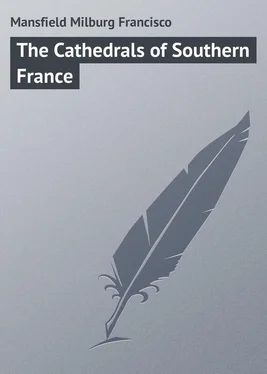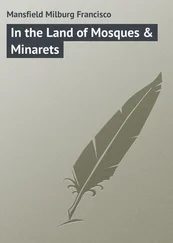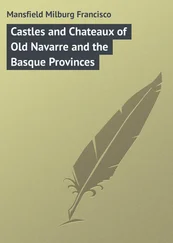Milburg Mansfield - The Cathedrals of Southern France
Здесь есть возможность читать онлайн «Milburg Mansfield - The Cathedrals of Southern France» — ознакомительный отрывок электронной книги совершенно бесплатно, а после прочтения отрывка купить полную версию. В некоторых случаях можно слушать аудио, скачать через торрент в формате fb2 и присутствует краткое содержание. Жанр: foreign_prose, Путешествия и география, на английском языке. Описание произведения, (предисловие) а так же отзывы посетителей доступны на портале библиотеки ЛибКат.
- Название:The Cathedrals of Southern France
- Автор:
- Жанр:
- Год:неизвестен
- ISBN:нет данных
- Рейтинг книги:4 / 5. Голосов: 1
-
Избранное:Добавить в избранное
- Отзывы:
-
Ваша оценка:
- 80
- 1
- 2
- 3
- 4
- 5
The Cathedrals of Southern France: краткое содержание, описание и аннотация
Предлагаем к чтению аннотацию, описание, краткое содержание или предисловие (зависит от того, что написал сам автор книги «The Cathedrals of Southern France»). Если вы не нашли необходимую информацию о книге — напишите в комментариях, мы постараемся отыскать её.
The Cathedrals of Southern France — читать онлайн ознакомительный отрывок
Ниже представлен текст книги, разбитый по страницам. Система сохранения места последней прочитанной страницы, позволяет с удобством читать онлайн бесплатно книгу «The Cathedrals of Southern France», без необходимости каждый раз заново искать на чём Вы остановились. Поставьте закладку, и сможете в любой момент перейти на страницу, на которой закончили чтение.
Интервал:
Закладка:
Mansfield M. F. Milburg Francisco
The Cathedrals of Southern France
TOO often – it is a half-acknowledged delusion, however – one meets with what appears to be a theory: that a book of travel must necessarily be a series of dull, discursive, and entirely uncorroborated opinions of one who may not be even an intelligent observer. This is mere intellectual pretence. Even a humble author – so long as he be an honest one – may well be allowed to claim with Mr. Howells the right to be serious, or the reverse, "with his material as he finds it;" and that "something personally experienced can only be realized on the spot where it was lived." This, says he, is "the prime use of travel, and the attempt to create the reader a partner in the enterprise" … must be the excuse, then, for putting one's observations on paper.
He rightly says, too, that nothing of perilous adventure is to-day any more like to happen "in Florence than in Fitchburg."
A "literary tour," a "cathedral tour," or an "architectural tour," requires a formula wherein the author must be wary of making questionable estimates; but he may, with regard to generalities, – or details, for that matter, – state his opinion plainly; but he should state also his reasons. With respect to church architecture no average reader, any more than the average observer, willingly enters the arena of intellectual combat, but rather is satisfied – as he should be, unless he is a Freeman, a Gonse, or a Corroyer – with an ampler radius which shall command even a juster, though no less truthful, view.
Not from one book or from ten, in one year or a score can this be had. The field is vast and the immensity of it all only dawns upon one the deeper he gets into his subject. A dictionary of architecture, a compendium or gazetteer of geography, or even the unwieldy mass of fact tightly held in the fastnesses of the Encyclopædia Britannica will not tell one – in either a long or a short while – all the facts concerning the cathedrals of France.
Some will consider that in this book are made many apparently trifling assertions; but it is claimed that they are pertinent and again are expressive of an emotion which mayhap always arises of the same mood.
Notre Dame at Rodez is a "warm, mouse-coloured cathedral;" St. Cécile d'Albi is at once "a fortress and a church," and the once royal city of Aigues-Mortes is to-day but "a shelter for a few hundred pallid, shaking mortals."
Such expressions are figurative, but, so far as words can put it, they are the concentrated result of observation.
These observations do not aspire to be considered "improving," though it is asserted that they are informative.
Description of all kinds is an art which requires considerable forethought in order to be even readable. And of all subjects, art and architecture are perhaps the most difficult to treat in a manner which shall not arouse an intolerant criticism.
Perhaps some credit will be attained for the attempts herein made to present in a pleasing manner many of the charms of the ecclesiastical architecture of southern France, where a more elaborate and erudite work would fail of its object. As Lady Montagu has said in her "Letters," – "We travellers are in very hard circumstances. If we say nothing new, we are dull, and have observed nothing. If we tell any new thing, we are laughed at as fabulous and romantic."
This book is intended as a contribution to travel literature – or, if the reader like, to that special class of book which appeals largely to the traveller.
Most lovers of art and literature are lovers of churches; indeed, the world is yearly containing more and more of this class. The art expression of a people, of France in particular, has most often first found its outlet in church-building and decoration. Some other countries have degenerated sadly from the idea.
In recent times the Anglo-Saxon has mostly built his churches, – on what he is pleased to think are "improved lines," – that, more than anything else, resemble, in their interiors, playhouses, and in their exteriors, cotton factories and breweries.
This seemingly bitter view is advanced simply because the writer believes that it is the church-members, using the term in its broad sense, who are responsible for the many outrageously unseemly church-buildings which are yearly being erected; not the architects – who have failings enough of their own to answer for.
It is said that a certain great architect of recent times was responsible for more bad architecture than any man who had lived before or since. Not because he produced such himself, but because his feeble imitators, without his knowledge, his training, or his ambition, not only sought to follow in his footsteps, but remained a long way in the rear, and stumbled by the way.
This man built churches. He built one, Trinity Church, in Boston, U. S. A., which will remain, as long as its stones endure, an entirely successful transplantation of an exotic from another land. In London a new Roman Catholic cathedral has recently been erected after the Byzantine manner, and so unexpectedly successful was it in plan and execution that its author was "medalled" by the Royal Academy; whatever that dubious honour may be worth.
Both these great men are dead, and aside from these two great examples, and possibly the Roman Catholic cathedral, and the yet unachieved cathedral of St. John the Divine, in New York City, where, in an English-speaking land, has there been built, in recent times, a religious edifice of the first rank worthy to be classed with these two old-world and new-world examples?
They do these things better in France: Viollet-le-Duc completed St. Ouen at Rouen and the cathedral at Clermont-Ferrand, in most acceptable manner. So, too, was the treatment of the cathedral at Moulins-sur-Allier – although none of these examples are among the noblest or the most magnificent in France. They have, however, been completed successfully, and in the true spirit of the original.
To know the shops and boulevards of Paris does not necessarily presume a knowledge of France. This point is mentioned here from the fact that many have claimed a familiarity with the cathedrals of France; when to all practical purposes, they might as well have begun and ended with the observation that Notre Dame de Paris stands on an island in the middle of the Seine.
The author would not carp at the critics of the first volume of this series, which appeared last season. Far from it. They were, almost without exception, most generous. At least they granted, unqualifiedly , the reason for being for the volume which was put forth bearing the title: "Cathedrals of Northern France."
The seeming magnitude of the undertaking first came upon the author and artist while preparing the first volume for the press. This was made the more apparent when, on a certain occasion, just previous to the appearance of the book, the author made mention thereof to a friend who did know Paris – better perhaps than most English or American writers; at least he ought to have known it better.
When this friend heard of the inception of this book on French cathedrals, he marvelled at the fact that there should be a demand for such; said that the subject had already been overdone; and much more of the same sort; and that only yesterday a certain Miss – had sent him an "author's copy" of a book which recounted the results of a journey which she and her mother had recently made in what she sentimentally called "Romantic Touraine."
Therein were treated at least a good half-dozen cathedrals; which, supplementing the always useful Baedeker or Joanne, and a handbook of Notre Dame at Paris and another of Rouen, covered – thought the author's friend at least – quite a representative share of the cathedrals of France.
Читать дальшеИнтервал:
Закладка:
Похожие книги на «The Cathedrals of Southern France»
Представляем Вашему вниманию похожие книги на «The Cathedrals of Southern France» списком для выбора. Мы отобрали схожую по названию и смыслу литературу в надежде предоставить читателям больше вариантов отыскать новые, интересные, ещё непрочитанные произведения.
Обсуждение, отзывы о книге «The Cathedrals of Southern France» и просто собственные мнения читателей. Оставьте ваши комментарии, напишите, что Вы думаете о произведении, его смысле или главных героях. Укажите что конкретно понравилось, а что нет, и почему Вы так считаете.












